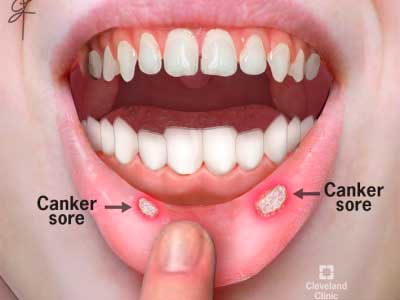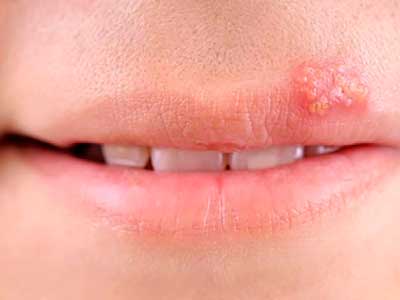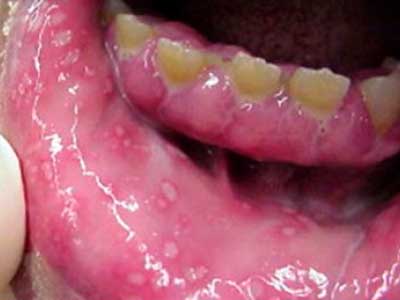Herpes and canker sore symptoms:
similarities and differences
In the table below, we summarize the common symptoms of herpes and canker sores. Symptoms-what you feel-might slightly precede signs-what you see-or appear at the same time.
It's important to consider symptoms in context: how soon they developed, what preceded them, how they're evolving over time, etc.
| Similarities of herpes and canker sore symptoms | Differences between herpes and canker sore symptoms |
|---|---|
| Both conditions can cause painful sores inside the mouth. | 1. Shooting (nerve) pain Herpes sores, unlike canker sores, can be preceded by tingling of the area and shooting nerve pain on the side of the lesion. 2. Systemic symptoms Unlike herpes sores, canker sores are not preceded by systemic symptoms. Systemic symptoms are fatigue, flu-like symptoms, fever, and swollen lymph nodes. 3. Causes Canker sores occur due to a minor |
Herpes and canker sore signs:
similarities and differences
In the table below, we summarize the common signs of herpes and canker sores.
Signs are more reliable than symptoms when it comes to establishing a diagnosis because they are more objective and can be seen by both the patient and the doctor.
| Similarities of herpes and canker sore symptoms | Differences between herpes and canker sore symptoms |
|---|---|
|
Location Both conditions can affect the inside of the mouth. Sore Both conditions can present as sores. No scarring Both canker sores and cold sore lesions heal without leaving a scar. Healing time Both herpes and canker sores heal within a week or two. |
Preferred area Canker sores are always inside the mouth affecting its lining: the gum line, tongue, and even throat. Herpes sores, on the other hand, usually affect the transitional areas of the skin where mucosa meets skin, and they are primarily located outside the mouth. Extent Canker sores can be on both sides of the mouth. Herpes sores are clustered on one side of the mouth following the skin dermatome and rarely cross the midline. Evolution A canker sore starts as a sore and stays a sore until it heals. Herpes sores evolve from a blister (fluid filled sac) Appearance A canker sore is a solitary sore that is a small oval shape with a red edge and white/yellow center (base). If multiple sores are present, they are usually separated by healthy tissue. Herpes sores are multiple lesions clustered on the same red base. The base (bottom) of a herpes mouth sore is clear. Depth Unlike herpes sores, which are usually very superficial, canker sores can extend deeper into the soft tissue. A canker sore can be confirmed visually or by touch (hardness is felt under the base). |
Images
The following photographs show the main differences between canker and herpes mouth sores.
Image 1.
This is a canker sore. As you can see, canker sores are
- Independent sores (separated by healthy tissue)
- With white/yellowish bases
- That go deeper than the superficial mucosal area
Image source: https://my.clevelandclinic.org/health/diseases/10945-canker-sores

Image 2.
This is a herpes blister affecting the mouth area.
Note the multiple blisters (just before turning into sores) clustered on the same red base.
Image source: https://www.dermsouthtx.com/articles/aad_education_library/563481-cold-sores

Image 3.
In this picture, you can see multiple superficial herpes virus sores.
The sores are superficial (even visually you can tell that), clustered on the same red base.
Image source: https://www.dermsouthtx.com/articles/aad_education_library/563481-cold-sores

FAQ
In his answers to these frequently asked questions, Dr. Fuzayloff discusses in more detail the important points that differentiate between canker and herpes mouth sores (also known as "cold sores").
What do you mean when you say it's important to put information in context?
When a doctor examines someone with a mouth sore and needs to differentiate between canker and herpes sores, they try to put the patient's signs and symptoms in context.
By this, we mean the history (what preceded the event), other symptoms and signs, the area involved, and how the mouth sores appeared and are evolving over time.
The activity that preceded the appearance of sores
Did you hurt your oral cavity by biting it or eating spicy food? If so, the likelihood of canker is high.
Have you had a new sexual partner? Did you have skin-to-skin contact (mouth-to-genital or mouth-to-mouth) with that person? Herpes can be contracted from sexual intercourse with a new partner.
The presence of systemic signs and symptoms
The presence of systemic symptoms is an important part of the context that helps differentiate herpes sores from canker sores.
- Herpes usually presents with systemic symptoms and signs (fever, lymph node enlargement, overall weakness, and flu-like symptoms). The systemic symptoms usually precede the actual outbreak or accompany it.
- A canker sore does not present with systemic symptoms and signs unless it is very big and deep, and it takes weeks to get to that stage. Systemic symptoms do not precede the appearance of the sore but may follow it (on rare occasions).
Preceding symptoms
Other symptoms that precede the appearance of the sores is another important part of the context. Unlike herpes sores, a canker sore is not preceded by tingling of the area and shooting nerve pain locally.
Preferred area
Herpes sores, unlike canker sores, prefers a "transitional skin" areas. This refers to areas where skin meet the mucosa-the border of the inside and outside of the mouth. Canker sores affect only the inside of the mouth.
Can we tell the difference just by looking at the sore?
Sore examination is 70% of the diagnosis (the other 30% is history and other associated symptoms and signs).
Here we going to review the main characteristics that help us differentiate between two conditions by only looking at the sores:
Canker sores
- A canker sore stays in one stage and does not evolve over time. It starts as a sore and stays a sore until it heals
- Canker sores are usually small oval sores with red edges. The base of the sore is white to yellow
- Canker sores are usually independent, separate sores and can affect different areas of the mouth
- Canker sores can affect deeper parts of the mouth mucosa but are mostly superficial
- If multiple sores are present, they can affect different areas of the mouth and, more importantly, both sides. The area between sores is healthy tissue
Herpes sores
- A herpes lesion evolves over time: it starts as redness, becomes a blister, and then turns into a sore
- They're clustered and usually share the same red base
- They may have different shapes and are filled with clear or yellowish fluid
- They're very superficial, affecting the top layer of the mucosa
- They're usually one-sided
*Note: the herpes symptoms and signs mentioned here are for newly acquired herpes, not recurrent outbreaks.
What causes canker sores and herpes sores?
Herpes sores are caused by herpes simplex 1 or 2 virus (usually type 1) and, like many infectious diseases, are transmitted from one person to another by direct skin-to-skin contact. The chance of transmission is about 20% if there are symptoms and 10% without visible symptoms ("silent shedding").
Canker sores are not infectious and cannot be passed by one person to another. Stress and other factors, such as genetic predisposition, vitamin deficiencies (B12, folic acid, and iron), hormonal shift (during menstrual period), toothpaste or mouthwash containing sodium lauryl sulfate, a weak immune system, and some others.
Can someone be genetically predisposed to canker sores or herpes sores?
Unlike herpes sores, someone can be predisposed genetically to canker sores, which means there's a higher-than-normal chance of their family members getting canker sores.
